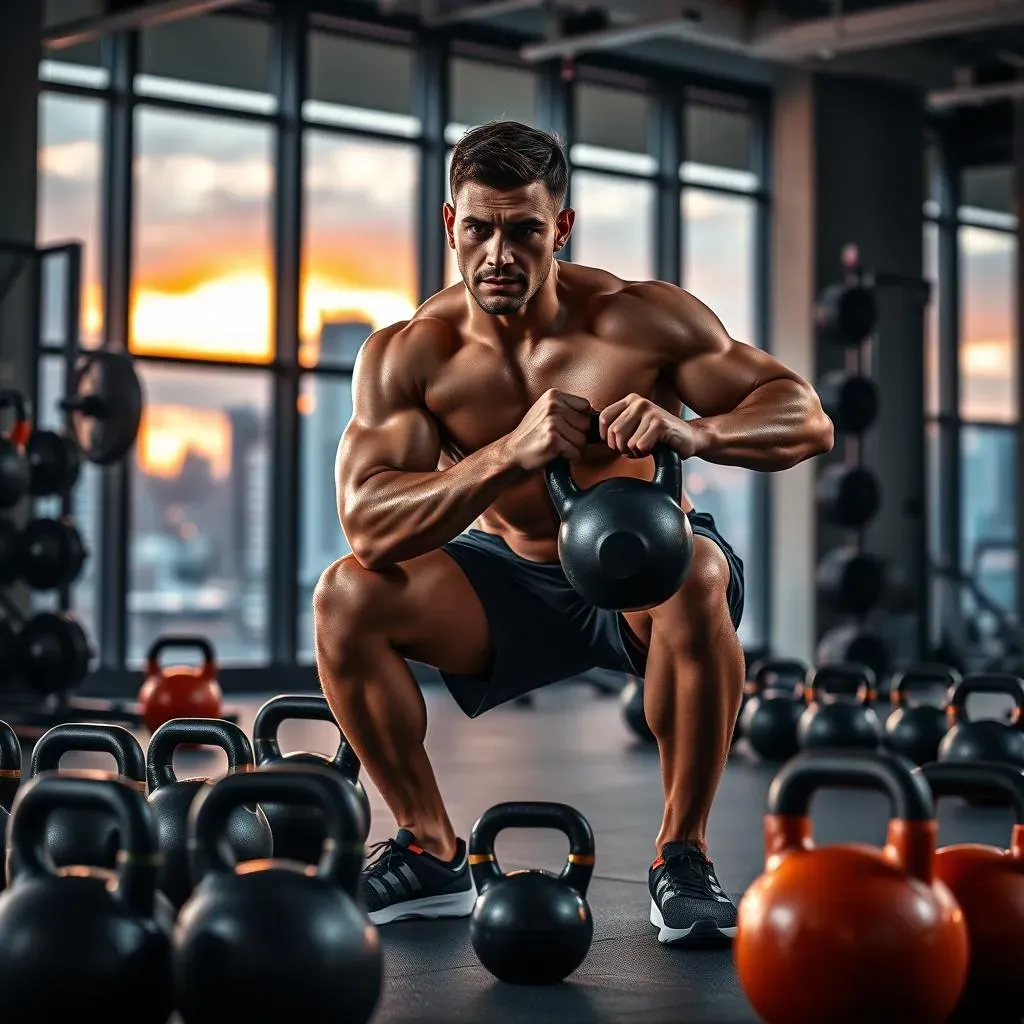Table of Contents
Ready to torch calories, build serious strength, and sculpt a physique that turns heads? Then it's time to dive into the world of the kettlebell leg and core workout. This isn't your grandma's aerobics class. We're talking dynamic movements, functional fitness, and results you can actually see and feel. Kettlebells offer a unique advantage, engaging your core and stabilizer muscles in ways traditional weights simply can't. Forget endless crunches and leg extensions. This guide will arm you with 12 of the most effective kettlebell exercises to build powerful legs and a rock-solid core. We'll break down each move, ensuring you nail the proper form to maximize results and minimize the risk of injury. Plus, we'll provide tips on how to craft your own killer kettlebell leg and core workout routine, tailored to your fitness level and goals. So, ditch the boring gym routine and get ready to swing, squat, and lunge your way to a stronger, leaner you!
Why Kettlebell Leg and Core Workouts Are a Game Changer

Why Kettlebell Leg and Core Workouts Are a Game Changer
More Than Just a Workout: It's Functional Fitness
Let's be real, traditional leg and core workouts can be, well, a bit of a drag. Endless reps on machines? Crunches until you can't feel your abs? No thanks! Kettlebell training throws all that out the window. It's about functional fitness, meaning you're training your body for real-life movements. Think about it: lifting groceries, carrying kids, even just getting up out of a chair. These all require leg and core strength, and kettlebells help you build that in a way that translates directly to your everyday life.
And it's not just about strength. Kettlebells are amazing for improving your balance, coordination, and even your cardiovascular fitness. The dynamic nature of kettlebell exercises forces your body to constantly stabilize and adjust, which builds incredible core strength and improves your overall athleticism. It's like hitting multiple birds with one very stylish, cast-iron stone.
The Core Connection: It's All About Stability
Forget isolating muscles; kettlebell movements demand full-body engagement. This is especially true for your core. Every swing, squat, and lunge requires your core to work overtime to stabilize your spine and maintain proper form. This not only builds strength but also improves your posture and reduces your risk of back pain.
Think of your core as the foundation of a building. If the foundation is weak, the entire structure is unstable. Kettlebell training builds a rock-solid core, giving you a stable base for all your movements, whether you're lifting weights, playing sports, or just going about your daily life.
Here's a quick comparison of core activation in different exercises:
Exercise | Core Activation Level | Why |
|---|---|---|
Kettlebell Swing | High | Requires significant core stabilization to control the momentum. |
Traditional Crunch | Low | Primarily isolates the abdominal muscles with limited stabilization needed. |
Kettlebell Goblet Squat | Medium-High | Holding the kettlebell in front increases core activation for balance. |
Beyond the Burn: Long-Term Benefits You'll Love
so we've established that kettlebell leg and core workouts are effective and functional. But what about the long-term benefits? Prepare to be impressed.
Regular kettlebell training can lead to:
- Improved posture and reduced back pain
- Increased bone density, reducing the risk of osteoporosis
- Enhanced athletic performance
- Better balance and coordination, reducing the risk of falls
- Increased calorie burn and improved body composition
Plus, let's not forget the mental benefits. Kettlebell training is challenging and engaging, which can help reduce stress, boost your mood, and improve your overall sense of well-being. It's a win-win!
12 Kettlebell Exercises to Fire Up Your Legs and Core

12 Kettlebell Exercises to Fire Up Your Legs and Core
Alright, now for the good stuff! Let's dive into 12 kettlebell exercises that will absolutely torch your legs and core. I'm not just throwing random moves at you; these are tried-and-true exercises that deliver serious results. We're talking strength, power, endurance, and a sculpted physique. Remember, form is key, so take your time and focus on mastering each movement before adding weight or increasing reps. Listen to your body, and don't be afraid to modify exercises as needed. Let’s get started!
1. Kettlebell Swings: The King of Kettlebell Exercises
The kettlebell swing is a full-body powerhouse that primarily targets your posterior chain (glutes, hamstrings, and back). It's also fantastic for improving your cardiovascular fitness and power output. Think of it as a dynamic deadlift with momentum. To do it correctly, stand with your feet shoulder-width apart, hinge at your hips (don't squat!), and swing the kettlebell between your legs. Then, explosively drive your hips forward to swing the kettlebell up to chest height. Control the descent and repeat.
Here are some tips for mastering the kettlebell swing:
- Keep your back straight and your core engaged.
- Focus on hinging at the hips, not squatting.
- Use your hips to generate power, not your arms.
- Control the kettlebell throughout the entire movement.
2. Goblet Squats: A Beginner-Friendly Leg Builder
Goblet squats are a great way to learn proper squat form and build leg strength. Holding the kettlebell in front of your chest (like you're holding a goblet) helps to counterbalance your weight and promotes a more upright posture. This exercise targets your quads, glutes, and core. To perform a goblet squat, hold the kettlebell close to your chest, stand with your feet shoulder-width apart, and squat down as low as you can while maintaining good form. Keep your back straight, your chest up, and your core engaged. Then, stand back up to the starting position.
3. Bulgarian Split Squats: Unilateral Leg Power
Bulgarian split squats are a unilateral exercise, meaning they work one leg at a time. This is great for improving balance, coordination, and stability, as well as addressing any muscular imbalances. To do them, place one foot on a bench or box behind you and stand with your other foot forward. Lower your body down until your front thigh is parallel to the ground, keeping your back straight and your core engaged. Then, push back up to the starting position. Repeat on the other side.
Here's a table comparing goblet squats and bulgarian split squats:
Exercise | Primary Muscles Worked | Benefits | Difficulty |
|---|---|---|---|
Goblet Squat | Quads, Glutes, Core | Beginner-friendly, improves squat form, increases core stability | Beginner to Intermediate |
Bulgarian Split Squat | Quads, Glutes, Hamstrings, Core | Unilateral strength, improves balance and coordination, addresses muscle imbalances | Intermediate to Advanced |
4. Single-Leg Deadlifts: Hamstring and Glute Activation
Single-leg deadlifts are another fantastic unilateral exercise that targets your hamstrings, glutes, and core. They also improve balance and stability. To perform a single-leg deadlift, hold a kettlebell in one hand and stand on the opposite leg. Hinge at your hips, lowering the kettlebell towards the ground while keeping your back straight and your core engaged. Extend your free leg behind you for balance. Then, return to the starting position by squeezing your glutes and hamstrings.
5. Racked Squats: Front-Loaded Strength
Racked squats are a variation of the traditional squat where you hold the kettlebells in the "racked" position (kettlebells resting on your forearms, close to your chest). This front-loaded position increases core activation and challenges your upper back strength. Perform the squat as you normally would, keeping your back straight, your chest up, and your core engaged.
6. Kettlebell Back Squats: Classic Strength Builder
Kettlebell back squats are similar to barbell back squats, but with kettlebells held behind your neck. This exercise builds serious lower body strength and power. To do it, clean the kettlebells up to your shoulders and position them behind your neck. Stand with your feet shoulder-width apart and squat down as low as you can while maintaining good form. Keep your back straight, your chest up, and your core engaged. Then, stand back up to the starting position.
7. Sumo Squats: Inner Thigh Focus
Sumo squats are a variation of the traditional squat that targets your glutes, adductors (inner thighs), hamstrings, and quads. Stand with your feet wider than shoulder-width apart and your toes pointed outwards. Hold a kettlebell in front of you with both hands. Squat down as low as you can while maintaining good form. Keep your back straight, your chest up, and your core engaged. Then, stand back up to the starting position.
8. Sumo Deadlifts: Glute and Hamstring Powerhouse
Sumo deadlifts are a variation of the traditional deadlift that targets your glutes, hamstrings, and quads. Stand with your feet wider than shoulder-width apart and your toes pointed outwards. Position the kettlebell between your legs. Hinge at your hips and grip the kettlebell with both hands. Keep your back straight, your chest up, and your core engaged. Then, lift the kettlebell off the ground by squeezing your glutes and hamstrings. Lower the kettlebell back to the ground with control.
9. Kettlebell Walking Lunges: Dynamic Leg Strength
Kettlebell walking lunges are a dynamic exercise that challenges your balance, coordination, and stability. Hold a kettlebell in each hand and lunge forward with one leg, lowering your body down until your front thigh is parallel to the ground. Keep your back straight and your core engaged. Then, step forward with your back leg and repeat the lunge on the other side. Continue walking forward, alternating legs.
10. Kettlebell Step-Ups: Functional Climbing Power
Kettlebell step-ups are a functional exercise that mimics the movement of climbing stairs or stepping onto a platform. They challenge your balance, coordination, and stability, as well as building leg strength. Hold a kettlebell in each hand and stand in front of a bench or box. Step onto the bench with one leg, driving through your heel to lift your body up. Then, step back down to the starting position. Repeat on the other side.
Here are some considerations for Walking Lunges and Step-Ups:
- Start with a low step or small weight to master form.
- Focus on controlled movements.
- Engage your core for balance.
11. Turkish Get-Ups: The Ultimate Full-Body Challenge
Turkish get-ups are a complex, full-body exercise that improves coordination, balance, and strength. They also challenge your core stability and shoulder mobility. This exercise is best learned with a trainer or experienced kettlebell user. It involves a series of movements, starting from a lying position on the ground and ending in a standing position, all while holding a kettlebell overhead.
12. Kettlebell Wall Sit: Isometric Endurance Test
Kettlebell wall sits are an isometric exercise that builds muscular endurance in your quads and core. Hold a kettlebell in front of you while leaning against a wall with your knees bent at a 90-degree angle. Hold the position for as long as you can, keeping your back flat against the wall and your core engaged. This is a burner!
Perfecting Your Form: Essential for Kettlebell Leg and Core Workout Safety

Perfecting Your Form: Essential for Kettlebell Leg and Core Workout Safety
Why Form Matters: More Than Just Looking Good
listen up! You can't just start swinging kettlebells around like a maniac and expect to get results without getting hurt. Perfecting your form is absolutely crucial, not just for maximizing the effectiveness of each exercise, but also for preventing injuries. We're talking about protecting your back, shoulders, knees – the whole shebang. Think of it this way: proper form is the foundation upon which you build strength. Without it, you're just setting yourself up for a fall (literally and figuratively).
It's tempting to rush through the movements, especially when you're feeling the burn. But trust me, slowing down and focusing on your technique will pay off in the long run. Not only will you avoid injuries, but you'll also engage the correct muscles and get more out of each rep. It's like the old saying goes: "Practice doesn't make perfect. Perfect practice makes perfect."
Here's a quick checklist to keep in mind before you start:
- Engage your core: This is your body's natural weight belt.
- Keep your back straight: Avoid rounding or arching your spine.
- Control the movement: Don't let the kettlebell control you.
- Breathe: Inhale before the exertion, exhale during the exertion.
Common Mistakes and How to Fix Them
Alright, let's talk about some common mistakes people make when performing kettlebell leg and core exercises. Knowing what to look out for is half the battle. One of the biggest culprits is rounding the back during swings and deadlifts. This puts excessive stress on your spine and can lead to serious injuries. The fix? Focus on hinging at the hips and keeping your back straight throughout the movement. Imagine you're trying to close a car door with your butt – that's the feeling you're going for.
Another common mistake is using your arms to lift the kettlebell during swings. Remember, the swing is a hip-hinge movement, not an arm raise. Your arms should be relaxed and simply guide the kettlebell. The power comes from your glutes and hamstrings. Also, watch out for knee valgus (knees caving inward) during squats and lunges. This can put stress on your knees and lead to pain and injuries. The fix? Focus on pushing your knees out to the side and engaging your glutes.
Here's a table of common mistakes and their solutions:
Mistake | Exercise | Solution |
|---|---|---|
Rounding Back | Swings, Deadlifts | Hinge at hips, keep back straight, engage core. |
Using Arms to Lift | Swings | Focus on hip hinge, relax arms, use glutes and hamstrings. |
Knee Valgus | Squats, Lunges | Push knees out, engage glutes, maintain alignment. |
Crafting Your Kettlebell Leg and Core Workout Routine

Crafting Your Kettlebell Leg and Core Workout Routine
Assessing Your Fitness Level: Know Thyself (and Your Kettlebell)
Before you jump headfirst into a grueling kettlebell leg and core workout, it's crucial to take a step back and assess your current fitness level. Are you a seasoned athlete, a weekend warrior, or a complete newbie to the world of fitness? Be honest with yourself! This will help you determine the appropriate weight, reps, and sets for your workouts. Starting too heavy or too intense can lead to injuries and discouragement. Start light, master the form, and gradually increase the challenge as you get stronger. Remember, it's a marathon, not a sprint.
Consider these factors when assessing your fitness level:
- Previous experience with kettlebells or other forms of resistance training
- Current strength and endurance levels
- Any existing injuries or limitations
- Your overall fitness goals
Designing Your Workout: Sets, Reps, and Exercise Selection
Alright, so you know your fitness level. Now it's time to design your kettlebell leg and core workout routine! This is where things get fun. The key is to choose exercises that target the muscles you want to work, while also challenging your cardiovascular system. Start with a warm-up to prepare your body for exercise, then move into your main workout, and finish with a cool-down to help your body recover.
Here's a sample workout structure:
Phase | Description | Duration |
|---|---|---|
Warm-up | Light cardio and dynamic stretching | 5-10 minutes |
Main Workout | Kettlebell leg and core exercises | 30-45 minutes |
Cool-down | Static stretching and light cardio | 5-10 minutes |
When it comes to exercise selection, choose a mix of compound exercises (like squats, deadlifts, and swings) and isolation exercises (like lunges and step-ups). This will help you build overall strength and muscle mass, while also targeting specific muscle groups. Aim for 2-3 sets of 8-12 reps for each exercise. As you get stronger, you can increase the weight, reps, or sets.
Here are some factors for designing your workout:
- Choose a variety of exercises that target all major muscle groups in your legs and core.
- Vary the intensity and volume of your workouts to avoid plateaus.
- Listen to your body and adjust your workout as needed.
Sample Kettlebell Leg and Core Workout Routines
Need some inspiration? Here are a few sample kettlebell leg and core workout routines to get you started. Remember to adjust the weight, reps, and sets to match your fitness level.
Beginner Routine:
- Goblet Squats: 3 sets of 10 reps
- Kettlebell Swings: 3 sets of 15 reps
- Walking Lunges: 3 sets of 10 reps per leg
- Kettlebell Wall Sit: 3 sets, hold for 30 seconds
Intermediate Routine:
- Racked Squats: 3 sets of 10 reps
- Single-Leg Deadlifts: 3 sets of 8 reps per leg
- Bulgarian Split Squats: 3 sets of 10 reps per leg
- Turkish Get-Ups: 3 sets of 1 rep per side
Advanced Routine:
- Kettlebell Back Squats: 3 sets of 8 reps
- Sumo Deadlifts: 3 sets of 8 reps
- Kettlebell Step-Ups: 3 sets of 10 reps per leg
- Kettlebell Swings: 3 sets of 20 reps
Remember, these are just examples. Feel free to mix and match exercises, adjust the reps and sets, and create your own unique kettlebell leg and core workout routine!
Elevate Your Fitness: The Kettlebell Leg and Core Workout Advantage
Incorporating a kettlebell leg and core workout into your fitness regime is a surefire way to boost strength, enhance stability, and sculpt your physique. Remember, consistency and proper form are key to unlocking the full potential of these exercises. By mastering the 12 kettlebell movements we've explored and tailoring a routine to your specific goals, you'll not only see noticeable improvements in your lower body and core strength but also experience enhanced functional fitness in your daily life. So, pick up that kettlebell, stay focused, and get ready to unleash your inner athlete. Your stronger, more resilient self awaits!